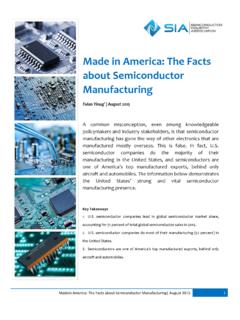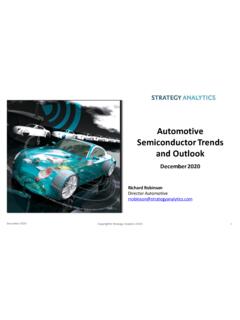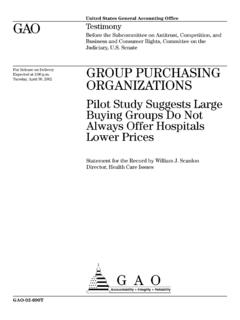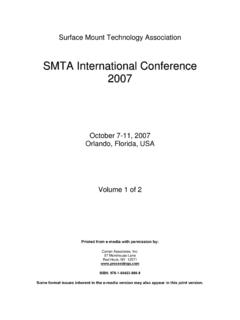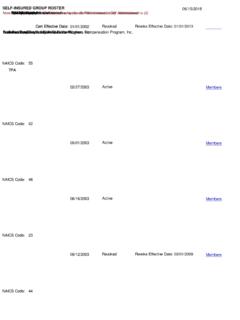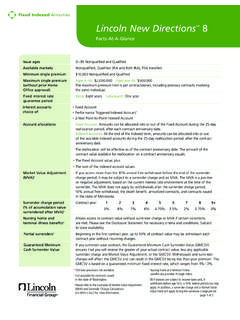Transcription of WINNING THE BATTLE AGAINST COUNTERFEIT …
1 WINNING THE BATTLE AGAINST COUNTERFEIT SEMICONDUCTOR PRODUCTSA report of the SIA Anti-Counterfeiting Task ForceAugust 2013 Copyright 2013 by the Semiconductor Industry Association1 WINNING the BATTLE AGAINST COUNTERFEIT Semiconductor ProductsSIA Anti-Counterfeiting Task ForceAugust 2013 Executive SummaryAs with every type of product , ranging from jewelry to wine to currency, semiconductor products can becounterfeited. semiconductors are the brains inside critically-important electronic systems, includinghealthcare and medical equipment, electric power grids, communications systems, automotive brakingand airbag systems, and military and aerospace systems.
2 Because they control the operation of theseand other vital electronics, COUNTERFEIT semiconductor components pose major risks to the health,safety, and security of people worldwide. Often harvested from electronic waste (e-waste), mostcounterfeit semiconductors are components re-marked to indicate they are newer than the originalunits or they perform to a higher standard. Semiconductor companies and their AuthorizedDistributors, Authorized Resellers, and Authorized Aftermarket Distributors/Manufacturers haveextensive, proven controls to ensure products are properly manufactured, tested, handled, and storedto prevent failures.
3 Counterfeiters have few if any such controls. The result is that, unlike legitimatesemiconductors from authorized sources, counterfeits and other semiconductors available from non-authorized sources often have low quality and poor to the dangers posed by counterfeits, the Semiconductor Industry Association (SIA) Anti-Counterfeiting Task Force (ACTF) continuously works to curtail the supply and demand for these illegalproducts and to educate customers on how to avoid purchasing counterfeits. The ACTF works closelywith government agencies worldwide, including Customs and other law enforcement agencies, toidentify and stop parties involved in manufacturing or trafficking in COUNTERFEIT goods.
4 In addition, theACTF has been instrumental in driving anti-counterfeiting legislation, regulations, and policies. The ACTF conveys COUNTERFEIT component avoidance strategies via conferences, webinars, and white semiconductor products have proliferated due to poor purchasing and supply chainpractices. COUNTERFEIT components reported to SIA member companies and reported through theGovernment-Industry Data Exchange Program (GIDEP) consistently involve purchases from open marketsources that are not authorized by the Original Component Manufacturers (OCMs) to manufacture orsell semiconductor products. The open market includes independent distributors, brokers, and on-linecomponent exchanges that obtain products from a wide range of suppliers.
5 Unfortunately, somesuppliers either intentionally or unknowingly introduce counterfeits into the open market supply only way to ensure that semiconductor components are authentic, and have optimal quality andreliability levels, is to buy them exclusively through authorized sources. The upfront costs of productspurchased through authorized sources are sometimes higher than those offered by open marketsources. However, products purchased through authorized sources are usually more cost effective inthe long term, since they have superior quality and reliability levels, and carry full factory 2013 by the Semiconductor Industry Association2 Table of Contents:Note: Sections are hyperlinked to immediately take readers to the sections of most on COUNTERFEIT of the Semiconductor Semiconductor Industry COUNTERFEIT semiconductors Threaten Health, Safety, and COUNTERFEIT semiconductors Cause Economic of COUNTERFEIT of Legitimate vs.
6 COUNTERFEIT of Legitimate vs. COUNTERFEIT Does Not Guarantee Performance and Authorized Supply Chains Prevent COUNTERFEIT Counterfeits Can Enter Non-Authorized Supply to Avoid COUNTERFEIT Legacy Strategies and Initiatives to Combat of How to Win the BATTLE AGAINST COUNTERFEIT Background on COUNTERFEIT SemiconductorsReports of COUNTERFEIT semiconductors first became widespread during the 1997-2000 dot-com boom,but COUNTERFEIT semiconductors have been around since at least the 1970s. Although counterfeitsemiconductors are not a new problem, there is no universally-accepted definition of counterfeitelectronic components.
7 In January 2010, the Bureau of Industry Security, which is part of the USDepartment of Commerce, published a report that defined a COUNTERFEIT electronic part as one that isnot genuine because it: is an unauthorized copy; does not conform to original OCM design, model, orperformance standards; is not produced by the OCM or is produced by unauthorized contractors; is anCopyright 2013 by the Semiconductor Industry Association3off-specification, defective, or used OCM product sold as new or working; or has incorrect or falsemarkings or documentation, or both. [Reference 1.] This is an excellent definition for a counterfeitsemiconductor, albeit rather lengthy.
8 A task force of experts on COUNTERFEIT semiconductors from sixworldwide semiconductor industry associations has agreed on the following more concise definition: Semiconductor counterfeiting is considered the act of fraudulently manufacturing, altering, distributing,or offering a product or package that is represented as genuine. As with other COUNTERFEIT goods,counterfeiters are trying to trick purchasers into thinking they are buying legitimate media coverage of COUNTERFEIT semiconductors became widespread in recent years, most people inthe semiconductor and electronics industries had little or no awareness of COUNTERFEIT prevailing view was that semiconductor products were too difficult and too expensive tocounterfeit, and that the supply chain for semiconductors minimized the likelihood of counterfeits beingintroduced.
9 While this view had some validity many years ago, four major changes since the mid-1990shave allowed COUNTERFEIT components to dot-com boom in the late 1990s and subsequent periods of strong semiconductor demandresulted in extended lead-times and rising prices for semiconductor components that madethese components attractive to environmental awareness resulted in electronics waste (e-waste) no longer alwaysending up in landfills. Instead, electronic components were often removed from scrap circuitboards sent for recycling, and some of these used components were then refurbished and re-marked to indicate they were new and/or higher performing of thousands of independent distributors and brokers worldwide established Internet sitesto buy and sell semiconductor products outside of the traditional supply chain of OCMs andtheir Authorized Distributors/Resellers.
10 As with other industries, the Internet and electroniccommerce have facilitated the sale of COUNTERFEIT and otherwise questionable components dueto the ease and speed at which companies and individuals can establish professional-lookingInternet sites and then quickly change company names, web addresses, contact information,etc. in an effort to avoid purchasers increasingly focused on price and availability, often orderingsemiconductor products from Internet-based brokers and on-line exchanges offering the lowestprices and immediate in the 1970s and 1980s there were negligible COUNTERFEIT semiconductors in the supply chain,beginning in the late 1990s, the combination of the above developments allowed counterfeitsemiconductors to proliferate.



